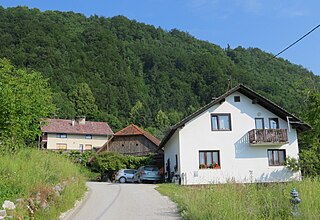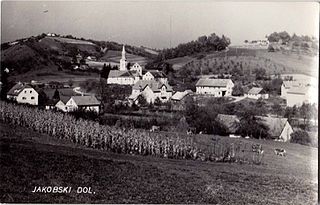| Spodnji Čačič | |
|---|---|
| Coordinates: 45°32′40.9″N14°42′45.39″E / 45.544694°N 14.7126083°E Coordinates: 45°32′40.9″N14°42′45.39″E / 45.544694°N 14.7126083°E | |
| Country | |
| Traditional region | Lower Carniola |
| Statistical region | Southeast Slovenia |
| Municipality | Osilnica |
| Area | |
| • Total | 0.07 km2 (0.03 sq mi) |
| Elevation | 545.3 m (1,789.0 ft) |
| Population (2002) | |
| • Total | 0 |
| [1] | |
Spodnji Čačič (pronounced [ˈspoːdnji ˈtʃaːtʃitʃ] ; German : Untertschatschitsch [2] ) is a small settlement in the Municipality of Osilnica in southern Slovenia. The area is part of the traditional region of Lower Carniola and is now included in the Southeast Slovenia Statistical Region. [3]

German is a West Germanic language that is mainly spoken in Central Europe. It is the most widely spoken and official or co-official language in Germany, Austria, Switzerland, South Tyrol (Italy), the German-speaking Community of Belgium, and Liechtenstein. It is also one of the three official languages of Luxembourg and a co-official language in the Opole Voivodeship in Poland. The languages which are most similar to German are the other members of the West Germanic language branch: Afrikaans, Dutch, English, the Frisian languages, Low German/Low Saxon, Luxembourgish, and Yiddish. There are also strong similarities in vocabulary with Danish, Norwegian and Swedish, although those belong to the North Germanic group. German is the second most widely spoken Germanic language, after English.

A municipality is usually a single urban administrative division having corporate status and powers of self-government or jurisdiction as granted by national and regional laws to which it is subordinate. It is to be distinguished (usually) from the county, which may encompass rural territory or numerous small communities such as towns, villages and hamlets.

Osilnica is a settlement in southern Slovenia. It is located on the left bank of the Kolpa River next to the border with Croatia. It is part of the traditional region of Lower Carniola and is now included in the Southeast Slovenia Statistical Region. It is the largest settlement and the centre of the Municipality of Osilnica
The local church in the settlement is dedicated to Saint Nicholas and belongs to the Parish of Osilnica. It was first mentioned in documents dating to 1526. In 1823 it was extended and in 1942 it was burned down together with the whole settlement. After 1945 it was rebuilt. [4]

A church building or church house, often simply called a church, is a building used for Christian religious activities, particularly for Christian worship services. The term is often used by Christians to refer to the physical buildings where they worship, but it is sometimes used to refer to buildings of other religions. In traditional Christian architecture, the church is often arranged in the shape of a Christian cross. When viewed from plan view the longest part of a cross is represented by the aisle and the junction of the cross is located at the altar area.

Saint Nicholas of Myra, also known as Nicholas of Bari, was an early Christian bishop of the ancient Greek city of Myra in Asia Minor during the time of the Roman Empire. He is revered by many Christians as a saint. Because of the many miracles attributed to his intercession, he is also known as Nicholas the Wonderworker. Saint Nicholas is the patron saint of sailors, merchants, archers, repentant thieves, children, brewers, pawnbrokers, and students in various cities and countries around Europe. His reputation evolved among the faithful, as was common for early Christian saints, and his legendary habit of secret gift-giving gave rise to the traditional model of Santa Claus through Sinterklaas.
A parish is a territorial entity in many Christian denominations, constituting a division within a diocese. A parish is under the pastoral care and clerical jurisdiction of a parish priest, who might be assisted by one or more curates, and who operates from a parish church. Historically, a parish often covered the same geographical area as a manor. Its association with the parish church remains paramount.








